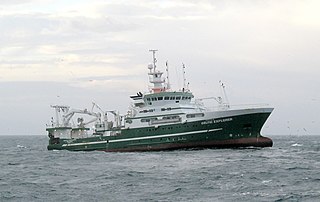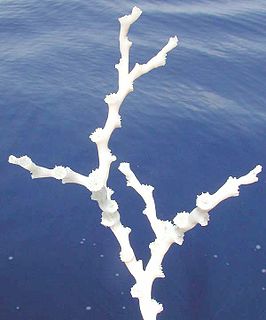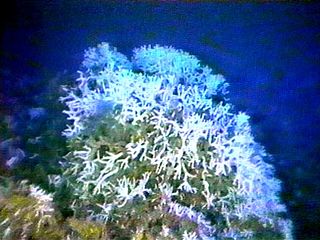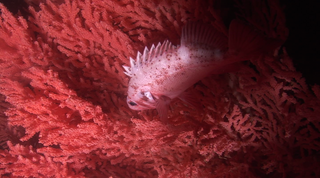
Trawling is a method of fishing that involves pulling a fishing net through the water behind one or more boats. The net used for trawling is called a trawl. This principle requires netting bags which are towed through water to catch different species of fishes or sometimes targeted species. Trawls are often called towed gear or dragged gear.

Bycatch, in the fishing industry, is a fish or other marine species that is caught unintentionally while fishing for specific species or sizes of wildlife. Bycatch is either the wrong species, the wrong sex, or is undersized or juveniles of the target species. The term "bycatch" is also sometimes used for untargeted catch in other forms of animal harvesting or collecting. Non-marine species that are caught but regarded as generally "undesirable" are referred to as "rough fish" and "coarse fish".

Anthozoa is a class of marine invertebrates which includes the sea anemones, stony corals and soft corals. Adult anthozoans are almost all attached to the seabed, while their larvae can disperse as part of the plankton. The basic unit of the adult is the polyp; this consists of a cylindrical column topped by a disc with a central mouth surrounded by tentacles. Sea anemones are mostly solitary, but the majority of corals are colonial, being formed by the budding of new polyps from an original, founding individual. Colonies are strengthened by calcium carbonate and other materials and take various massive, plate-like, bushy or leafy forms.

Sea pens are colonial marine cnidarians belonging to the order Pennatulacea. There are 14 families within the order; 35 extant genera, and it is estimated that of 450 described species, around 200 are valid. Sea pens have a cosmopolitan distribution, being found in tropical and temperate waters worldwide, as well as from the intertidal to depths of more than 6100 m. Sea pens are grouped with the octocorals, together with sea whips (gorgonians).

Bottom trawling is trawling along the seafloor. It is also referred to as "dragging". The scientific community divides bottom trawling into benthic trawling and demersal trawling. Benthic trawling is towing a net at the very bottom of the ocean and demersal trawling is towing a net just above the benthic zone. Bottom trawling can be contrasted with midwater trawling, where a net is towed higher in the water column. Midwater trawling catches pelagic fish such as anchovies and mackerel, whereas bottom trawling targets both bottom-living fish (groundfish) and semi-pelagic species such as cod, squid, shrimp, and rockfish.

Lophelia pertusa, the only species in the genus Lophelia, is a cold-water coral which grows in the deep waters throughout the North Atlantic ocean, as well as parts of the Caribbean Sea and Alboran Sea. L. pertusa reefs are home to a diverse community, however the species is extremely slow growing and may be harmed by destructive fishing practices, or oil exploration and extraction.

Pelagic fish live in the pelagic zone of ocean or lake waters – being neither close to the bottom nor near the shore – in contrast with demersal fish that do live on or near the bottom, and reef fish that are associated with coral reefs.

The blackmouth catshark is a species of catshark, and part of the family Scyliorhinidae, common in the northeastern Atlantic Ocean from Iceland to Senegal, including the Mediterranean Sea. It is typically found over the continental slope at depths of 150–1,400 m (490–4,590 ft), on or near muddy bottoms. The youngest sharks generally inhabit shallower water than the older juveniles and adults. This slim-bodied species is characterized by the black interior of its mouth, a marbled pattern of pale-edged brownish saddles or blotches along its back and tail, and a prominent saw-toothed crest of enlarged dermal denticles along the upper edge of its caudal fin. It reaches lengths of 50–79 cm (20–31 in), with sharks in the Atlantic growing larger than those in the Mediterranean.

The Greenland halibut or Greenland turbot belongs to the family Pleuronectidae, and is the only species of the genus Reinhardtius. It is a predatory fish that mostly ranges at depths between 500 and 1,000 m (1,600–3,300 ft), and is found in the cold northern Atlantic, northern Pacific, and Arctic Oceans. It has a variety of other English vernacular names, including black halibut, blue halibut, lesser halibut, and Newfoundland turbot; while both Newfoundland turbot and Greenland turbot are in common use in North America, these names are typically not used in Europe, where they can cause easy confusion with the true turbot.

The smalleyed ray or smalleyed skate is a species of ray in the family Rajidae, the typical rays and skates, from the eastern Atlantic Ocean where it is found in tidal, coastal waters with sandy substrates.

Oculina varicosa, or the ivory bush coral, is a scleractinian deep-water coral primarily found at depths of 70-100m, and ranges from Bermuda and Cape Hatteras to the Gulf of Mexico and the Caribbean. Oculina varicosa flourishes at the Oculina Bank off the east coast of Florida, where coral thickets house a variety of marine organisms. The U.S. National Marine Fisheries Service considers Oculina a genus of concern, due to the threat of rapid ocean warming. Species of concern are those species about which the U.S. Government's National Oceanic and Atmospheric Administration (NOAA), National Marine Fisheries Service, has some concerns regarding status and threats, but for which insufficient information is available to indicate a need to list the species under the U.S. Endangered Species Act (ESA). While Oculina is considered a more robust genus in comparison to tropical corals, rising ocean temperatures continue to threaten coral health across the planet.

The habitat of deep-water corals, also known as cold-water corals, extends to deeper, darker parts of the oceans than tropical corals, ranging from near the surface to the abyss, beyond 2,000 metres (6,600 ft) where water temperatures may be as cold as 4 °C (39 °F). Deep-water corals belong to the Phylum Cnidaria and are most often stony corals, but also include black and thorny corals and soft corals including the Gorgonians. Like tropical corals, they provide habitat to other species, but deep-water corals do not require zooxanthellae to survive.

Aurelia is a genus of scyphozoan jellyfish, commonly called moon jellies. There are currently 25 accepted species and many that are still not formally described.
This is a glossary of terms used in fisheries, fisheries management and fisheries science.
Destructive fishing practices are practices that easily result in irreversible damage to aquatic habitats and ecosystems. Many fishing techniques can be destructive if used inappropriately, but some practices are particularly likely to result in irreversible damage. These practices are mostly, though not always, illegal. Where they are illegal, they are often inadequately enforced.

Coralliidae, also known as precious corals, is a taxonomic family of soft corals belonging to the phylum Cnidaria of the family Scleraxonia. These sessile corals are one of the most dominant members of hard-bottomed benthics environments such as seamounts, canyons and continental shelves. From this coral family results 69 descendants in which each species plays a key role in forming habitats for a variety of marine species. Due to their unique trait of possessing a red calcium carbonate skeleton, these corals can be harvested in order to create handcrafted amulets, jewelry and other valuable artifacts giving rise to its reputed name of "precious corals". Correspondingly, members of this family are vulnerable to the negative impacts of overharvestation imposed by mass coral trade.

Primnoa(Lamororux, 1812) also known as red tree coral, is a genus of soft corals and the type genus of the family Primnoidae (Milne Edwards, 1857). They are sessile, benthic cnidarians that can be found in the North Pacific, North Atlantic, and Subantarctic South Pacific, and its members often play a vital ecological role as keystone species within their environment as a habitat and refuge for the megafauna that also inhabit those regions. This, in combination with their slow growth, makes the increasing disturbance to their habitats caused by fishing activities particularly impactful and difficult to recover from.

The Community of Arran Seabed Trust (COAST) is a registered Scottish charity based on the Isle of Arran, the largest island in the Firth of Clyde. Established in 1995 by two local divers COAST has been a registered charity since 2011 and is run mostly by Arran residents, who all share the same aims to protect the health of the marine environment around the Isle of Arran and within the Firth of Clyde from indiscriminate commercial fishing methods. COAST values the marine biodiversity around the shoreline of Arran and aims to regenerate and protect it for future generations.

Paragorgia arborea is a species of coral in the family Paragorgiidae, commonly known as the bubblegum coral because of its bulbous branch tips. It mainly grows in depths between 200 and 1,300 metres at temperatures between 3 and 8 °C. It is found widespread in the Northern Atlantic Ocean and Northern Pacific Ocean on seamounts and knolls, and was first described by the Swedish naturalist Carl Linnaeus in 1758. P. arborea is a foundation species, providing a habitat for other species in deep sea coral ecosystems.
The slender sea pen is a species of sea pen in the family Virgulariidae, occurring throughout the Mediterranean and Western Europe, with some colonies being found on islands in the Mid-Atlantic.

















